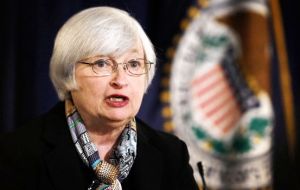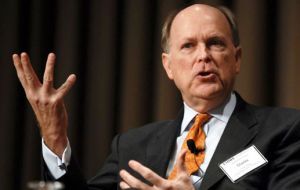MercoPress. South Atlantic News Agency
Yellen insists with expansive policies despite growing pressure from 'hawks' on interest rate
 “Five years after the end of the recession, the labor market has yet to fully recover,” argues Fed chief Yellen
“Five years after the end of the recession, the labor market has yet to fully recover,” argues Fed chief Yellen  Philadelphia Fed chief Plosser says the jobless rate decline is real and the low participation rate as a sign of fundamental changes in the labor market
Philadelphia Fed chief Plosser says the jobless rate decline is real and the low participation rate as a sign of fundamental changes in the labor market Federal Reserve Chair Janet Yellen said Friday that the US jobs market has not yet fully recovered, but acknowledged that data is sending mixed signals, spurring debate over inflationary pressures. In a speech to leading central bankers in Jackson Hole, Wyoming, Yellen, who has kept Fed policy expansive due to perceived excess slack in the jobs market, gave no clear new signs for monetary policy.
Alluding to the rising pressure from so-called inflation hawks inside and outside the Fed to begin tightening policy, she admitted that analyzing the data has been “especially challenging recently”.
The hawks argue that the sharp fall of the jobless rate to 6.2% is a clear foretoken of inflation and want the Fed to move forward its timeline for an interest rate hike next year.
While agreeing that the data is sending mixed signals, Yellen did not embrace the argument that a burst of inflation is looming and demands a decisive policy adjustment, like moving forward an interest rate hike to early 2015 from later in the year.
There still remains “considerable uncertainty about the level of employment,” she told the Fed's annual central banking symposium, according to the text of her remarks. “There is no simple recipe for appropriate policy in this context.”
Yellen picked through the various arguments over what the seemingly contradictory data says: the faster-than-expected fall in the jobless rate to 6.2% from 7.3% a year ago, against the persistently extremely low labor force participation rate since the Great Recession, just 62.9%.
Inflation hawks, like Philadelphia Fed chief Charles Plosser, a member of the policy-setting Federal Open Market Committee, argue that the jobless rate decline is real. They downplay the low participation rate as a sign of not cyclical joblessness but fundamental changes in the labor market, including demographic shifts.
Yellen agreed that there have been some structural changes that have affected the way the labor market signals tightening through indicators such as part-time work, the number of people leaving jobs, and wage gains -- which have been virtually insignificant since the recession ended in 2009.
But she insisted that the combined data that the Fed is reviewing suggests that the jobless rate decline “somewhat overstates” labor market improvements.
“Five years after the end of the recession, the labor market has yet to fully recover,” she said.
That, analysts said, was a sign for the moment that the Fed would be sticking to its forecast that its benchmark federal funds interest rate would remain at the near-zero level, where it has been for nearly six years, until the second half of 2015.




Top Comments
Disclaimer & comment rules-

Read all comments“Philadelphia Fed chief Plosser says the jobless rate decline is real and the low participation rate as a sign of fundamental changes in the labor market”
Aug 24th, 2014 - 10:26 pm 0Yes,because you took the lead from The Cunt Brown © Jeremy Clarkson 2010 who removed all the people who couldn't find jobs and put them of soft hand-outs that did not show on the jobless total.
Put those back on and see where your total is then.
All this throwing money down the drain has come about from “saving” those organisations that “were too big to fail”.
A lot of us said this was wrong and would only end up with massive debt for ordinary citizens and an econonomy unable to pick itself up from the floor where the likes of these idiots put it. And it looks like we were correct.
Commenting for this story is now closed.
If you have a Facebook account, become a fan and comment on our Facebook Page!